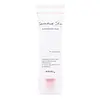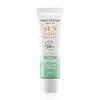What's inside
What's inside
 Key Ingredients
Key Ingredients

 Benefits
Benefits

 Concerns
Concerns

No concerns
 Ingredients Side-by-side
Ingredients Side-by-side

Water
Skin ConditioningSqualane
EmollientIsononyl Isononanoate
EmollientGlycerin
HumectantButylene Glycol
HumectantPEG-100 Stearate
Xanthan Gum
EmulsifyingCarbomer
Emulsion StabilisingHexanediol
SolventCaprylyl Glycol
EmollientTrehalose
HumectantSodium Hyaluronate
HumectantCollagen
MoisturisingAminomethyl Propanol
BufferingAloe Barbadensis Leaf Juice Powder
Skin ConditioningCentella Asiatica Extract
CleansingPolygonum Cuspidatum Root Extract
AntioxidantScutellaria Baicalensis Root Extract
AstringentCamellia Sinensis Leaf Extract
AntimicrobialGlycyrrhiza Glabra Root Extract
BleachingChamomilla Recutita Flower Extract
MaskingRosmarinus Officinalis Leaf Extract
AntimicrobialPanicum Miliaceum Seed Extract
Skin ConditioningLactobacillus Ferment
Skin ConditioningPolyquaternium-51
Skin ConditioningSodium Benzoate
MaskingPotassium Sorbate
PreservativeWater, Squalane, Isononyl Isononanoate, Glycerin, Butylene Glycol, PEG-100 Stearate, Xanthan Gum, Carbomer, Hexanediol, Caprylyl Glycol, Trehalose, Sodium Hyaluronate, Collagen, Aminomethyl Propanol, Aloe Barbadensis Leaf Juice Powder, Centella Asiatica Extract, Polygonum Cuspidatum Root Extract, Scutellaria Baicalensis Root Extract, Camellia Sinensis Leaf Extract, Glycyrrhiza Glabra Root Extract, Chamomilla Recutita Flower Extract, Rosmarinus Officinalis Leaf Extract, Panicum Miliaceum Seed Extract, Lactobacillus Ferment, Polyquaternium-51, Sodium Benzoate, Potassium Sorbate
Water
Skin ConditioningButyl Methoxydibenzoylmethane
UV AbsorberEthylhexyl Salicylate
UV AbsorberEthylhexyl Triazone
UV AbsorberDibutyl Adipate
EmollientSilica
AbrasiveButylene Glycol
HumectantNeopentyl Glycol Diheptanoate
EmollientDiethylamino Hydroxybenzoyl Hexyl Benzoate
UV FilterCetearyl Alcohol
EmollientPhenoxyethanol
PreservativeGlyceryl Stearate
EmollientPEG-100 Stearate
Potassium Cetyl Phosphate
EmulsifyingBis-Ethylhexyloxyphenol Methoxyphenyl Triazine
Skin ConditioningDimethicone
EmollientChlorphenesin
AntimicrobialTitanium Dioxide
Cosmetic ColorantAcrylates/C10-30 Alkyl Acrylate Crosspolymer
Emulsion StabilisingCetearyl Glucoside
EmulsifyingVp/Hexadecene Copolymer
Potassium Hydroxide
BufferingGluconolactone
Skin ConditioningTocopheryl Acetate
AntioxidantDisodium EDTA
Ethylhexylglycerin
Skin ConditioningCarbomer
Emulsion StabilisingCocamidopropyl Dimethylamine
EmulsifyingGlycerin
HumectantSea Water
HumectantPropanediol
SolventSalicylic Acid
MaskingSodium Lauroyl Lactylate
EmulsifyingBuddleja Officinalis Flower Extract
UV FilterPolysorbate 80
EmulsifyingCeramide NP
Skin ConditioningCeramide AP
Skin ConditioningPhytosphingosine
Skin ConditioningCholesterol
EmollientXanthan Gum
EmulsifyingAnthemis Nobilis Flower Extract
MaskingAscorbic Acid
AntioxidantBenzalkonium Chloride
AntimicrobialButyrospermum Parkii Butter
Skin ConditioningCamellia Sinensis Leaf Extract
AntimicrobialCera Alba
EmollientFucus Vesiculosus Extract
EmollientIsomerized Safflower Acid
Skin ConditioningKaolin
AbrasiveMaltodextrin
AbsorbentPalmitic Acid
EmollientPalmitoyl Tripeptide-5
Skin ConditioningZinc Sulfate
AntimicrobialCeramide EOP
Skin ConditioningWater, Butyl Methoxydibenzoylmethane, Ethylhexyl Salicylate, Ethylhexyl Triazone, Dibutyl Adipate, Silica, Butylene Glycol, Neopentyl Glycol Diheptanoate, Diethylamino Hydroxybenzoyl Hexyl Benzoate, Cetearyl Alcohol, Phenoxyethanol, Glyceryl Stearate, PEG-100 Stearate, Potassium Cetyl Phosphate, Bis-Ethylhexyloxyphenol Methoxyphenyl Triazine, Dimethicone, Chlorphenesin, Titanium Dioxide, Acrylates/C10-30 Alkyl Acrylate Crosspolymer, Cetearyl Glucoside, Vp/Hexadecene Copolymer, Potassium Hydroxide, Gluconolactone, Tocopheryl Acetate, Disodium EDTA, Ethylhexylglycerin, Carbomer, Cocamidopropyl Dimethylamine, Glycerin, Sea Water, Propanediol, Salicylic Acid, Sodium Lauroyl Lactylate, Buddleja Officinalis Flower Extract, Polysorbate 80, Ceramide NP, Ceramide AP, Phytosphingosine, Cholesterol, Xanthan Gum, Anthemis Nobilis Flower Extract, Ascorbic Acid, Benzalkonium Chloride, Butyrospermum Parkii Butter, Camellia Sinensis Leaf Extract, Cera Alba, Fucus Vesiculosus Extract, Isomerized Safflower Acid, Kaolin, Maltodextrin, Palmitic Acid, Palmitoyl Tripeptide-5, Zinc Sulfate, Ceramide EOP
Ingredients Explained
These ingredients are found in both products.
Ingredients higher up in an ingredient list are typically present in a larger amount.
Butylene Glycol (or BG) is used within cosmetic products for a few different reasons:
Overall, Butylene Glycol is a safe and well-rounded ingredient that works well with other ingredients.
Though this ingredient works well with most skin types, some people with sensitive skin may experience a reaction such as allergic rashes, closed comedones, or itchiness.
Learn more about Butylene GlycolCamellia Sinensis Leaf Extract is derived from the leaves of the tea plant. Black tea, green tea, and oolong tea are all harvested from this plant.
This ingredient has many skin benefits:
This ingredient contains polyphenols, a strong antioxidant. Antioxidants help fight off molecules that damage skin cells.
On top of that, the antioxidants in green tea neutralize free-radicals from the sun. This gives the skin some extra UV protection, but should not replace sunscreen.
Many components of tea have anti-inflammatory properties.
Polyphenols and L-theanine help soothe the skin and reduce irritation. The caffeine in Camellia Sinensis Leaf Extract helps calm inflamed blood vessels.
Other compounds found in tea include: Vitamin Bs, linoleic acid, magnesium, calcium, iron, and zinc.
Research has shown both drinking Camellia Sinensis Leaf Tea and applying it to the skin can help boost skin elasticity and hydration. Studies also show using tea extract may reduce sebum, or oil, production.
Learn more about Camellia Sinensis Leaf ExtractCarbomer is a polymer of acrylic acid. Its main role is to create a gel consistency.
A high amount of carbomer can cause pilling or balling up of products. Don't worry, most products contain 1% or less of carbomer.
Glycerin is already naturally found in your skin. It helps moisturize and protect your skin.
A study from 2016 found glycerin to be more effective as a humectant than AHAs and hyaluronic acid.
As a humectant, it helps the skin stay hydrated by pulling moisture to your skin. The low molecular weight of glycerin allows it to pull moisture into the deeper layers of your skin.
Hydrated skin improves your skin barrier; Your skin barrier helps protect against irritants and bacteria.
Glycerin has also been found to have antimicrobial and antiviral properties. Due to these properties, glycerin is often used in wound and burn treatments.
In cosmetics, glycerin is usually derived from plants such as soybean or palm. However, it can also be sourced from animals, such as tallow or animal fat.
This ingredient is organic, colorless, odorless, and non-toxic.
Glycerin is the name for this ingredient in American English. British English uses Glycerol/Glycerine.
Learn more about GlycerinPeg-100 Stearate is an emollient and emulsifier. As an emollient, it helps keep skin soft by trapping moisture in. On the other hand, emulsifiers help prevent oil and water from separating in a product.
PEGS are a hydrophilic polyether compound . There are 100 ethylene oxide monomers in Peg-100 Stearate. Peg-100 Stearate is polyethylene glycol ester of stearic acid.
Water. It's the most common cosmetic ingredient of all. You'll usually see it at the top of ingredient lists, meaning that it makes up the largest part of the product.
So why is it so popular? Water most often acts as a solvent - this means that it helps dissolve other ingredients into the formulation.
You'll also recognize water as that liquid we all need to stay alive. If you see this, drink a glass of water. Stay hydrated!
Learn more about WaterXanthan gum is used as a stabilizer and thickener within cosmetic products. It helps give products a sticky, thick feeling - preventing them from being too runny.
On the technical side of things, xanthan gum is a polysaccharide - a combination consisting of multiple sugar molecules bonded together.
Xanthan gum is a pretty common and great ingredient. It is a natural, non-toxic, non-irritating ingredient that is also commonly used in food products.
Learn more about Xanthan Gum